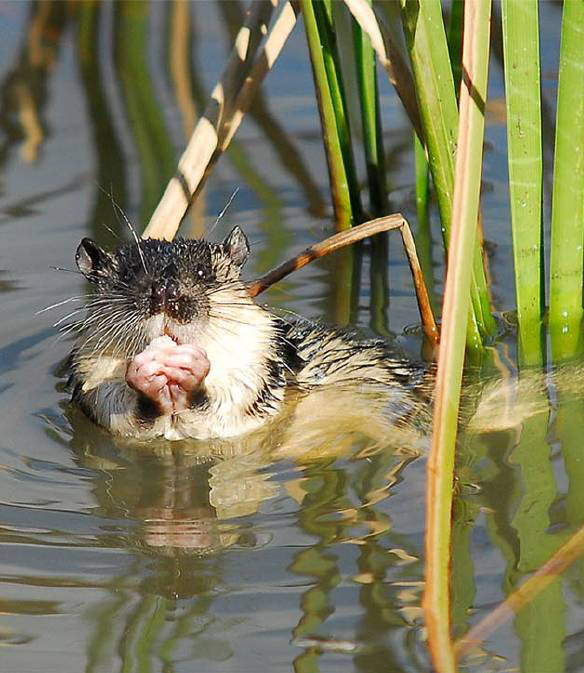RAKALI OR AUSTRALIAN WATER RAT (HYDROMYS CHRYSOGASTER)
The name Rakarli comes from the Aboriginal language around the Murray Darling River system. Local Aboriginal names include Murit-ya, Ngoor-joo and Ngurju in the south west of Western Australia.
The Rakali is a large aquatic rodent that is highly adapted to its environment, has broad partially webbed hind feet to aid in swimming, long, thick and muscular body and usually white tipped long tail that is just shorter than the body. It has a long broad slightly flattened face with long whiskers and small eyes, ears and nostrils set high on the head. The dense water repellent fur is shiny, varies from slaty grey to almost black above and white to orange below.
The size of the animals’ body for males is around 310mm and females 290mm with tail lengths of 275mm and 270mm respectively. Males weight around 750 grams and females around 600grams.
Behaviour:
Often the only sign of Rakali you will see are small deposits of the shells (feeding Middens) on logs and rocks located along the banks of rivers and pools where they carry their food to feed on larger prey. Their footprints can also be seen in muddy areas with distinctive imprints of their webbed back feet, these can be sometimes be mistaken for other rodents but adult prints are a little larger than a 20 cent piece. They rest in nests built in hollow logs or at the end of burrows dug into river banks
Habitat and Distribution:
The Rakali use riparian vegetation in the vicinity of permanent pools in rivers, lakes and dams of fresh or brackish water (including western parts of the Avon Wheatbelt) and also coastal marine environments.
Diet:
The animals are aquatic predators feeding on marron, gilgies, insects, fish and mussels. They also sometimes eat small mammals and birds when they can catch them.
Reproduction:
Rakali live for 3-4 years, are known to breed all year round but mostly from spring to late summer, the females are mature at eight months of age, gestation is around 34 days and they have 3-4 young which follow the mother until they are independent at around 8 weeks.
Threats:
The population declines in Western Australia have been caused by habitat loss and degradation in the areas close to rivers. This has enabled both natural predators (snakes, birds of prey and quolls) and introduced predators (foxes and cats) to place addition pressure on individual populations.
Water quality, changes in hydrology and climate change all impact populations and food sources of the species.
Some traps like the ”opera-house trap” illegally used to catch marron and gilgies in public waterways in Western Australia and legally on private land frequently capture and kill Rakali.
Management Actions:
Improving management of riverine vegetation and therefore water quality through activities like fencing and revegetation and leaving natural features like logs and rocks.
Control of stock access to waterways and of introduced foxes, cats and rodents.
Stop using harmful marron traps on private properties or ensure Rakali can’t get into the traps.
On a catchment level reduce the inputs into the river from chemicals, fertilisers and sediment through improving agricultural land management practices.
Rakali Facts
Size (head and body length)
Male 230-345 (310)mm
Female 245-370 (290)mm
Size (tail length)
Male 225-320 (275)mm
Female 240-325 (270)mm
Weight
Male 400-1275 (755)g
Female 340-990 (600)g
Further Reading:
River Conservation Society – Water Rat Project
Trigg, B. (2013) Tracks, Scats and other Traces: A Field Guide to Australian Mammals. Oxford University Press Merlbourne.
Olsen, P.D. (2008). Water-rat. In Van Dyck, and R. Strahan (eds.), The Mammas of Australia. Reed New Holland, Sydney.


